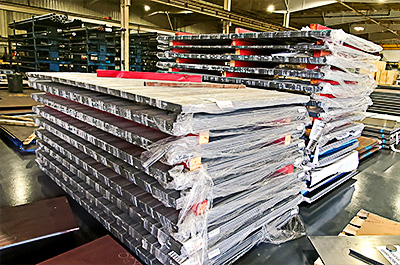I'm sure you've seen one and maybe know what they're called: a Rube Goldberg machine:
A Rube Goldberg machine, named after American cartoonist Rube Goldberg, is a chain reaction-type machine or contraption intentionally designed to perform a simple task indirectly and overly complicated. Usually, these machines comprise a series of simple unrelated devices; the action of each triggers the initiation of the next, eventually resulting in achieving a stated goal.
In a nutshell, the Goldberg machine accurately illustrates how unrelated events impact the tight steel market in the United States. It's more than the simple Laws of Supply and Demand.
The Problem of Steel
In the last year, prices of steel have risen exponentially. Prices are triple the 20-year average. As if the prices aren't bad enough, good luck trying to find steel.
At first glance, there are three primary reasons given for our current situation:
- The Trump Tariffs
- Covid and the resulting worldwide shutdown
- Domestic inventories—before the economic recovery, steel inventories were at historic lows.
 One person whose job is to grapple with steel inventories is Schuette Metal's Materials Manager, Jim Shebelski. Besides the three reasons above, there are other factors involved.
One person whose job is to grapple with steel inventories is Schuette Metal's Materials Manager, Jim Shebelski. Besides the three reasons above, there are other factors involved.
Along with these three, Winter Storm URI also caused the Texas power crisis, resulting in the most extensive blackouts in the country since the 2003 Northeast blackout. These outages meant refineries went without power, suddenly cutting off the supply of fuel needed to fire steel furnaces.
In addition, Shebelski mentioned the much-publicized shipping fiasco that took place in the Suez Canal:
Another factor was the Ever Given container ship getting stuck in the Suez Canal, blocking traffic for nearly a week. Much of the traffic, including the Ever Given, was carrying steel.
As you can see, the issues our economy is dealing with don't have a single reason. Hence, the Rube Goldberg scenario: various unrelated incidents resulting in a market dealing with chaos.
Trump's Tariffs
To save domestic steel production, President Trump instituted a 25% tariff on imported steel. Political ramifications aside, it's surprising to see domestic steel producers wanting the current Biden administration to keep the tariffs in place. (https://bit.ly/3CCmU7n)
Shebelski believes the idea behind President Biden simply lifting the tariffs doesn't happen without consequence.
I believe the Biden administration understands that simply lifting the tariffs with no fallback strategies could negatively affect the market, both economically and politically. I believe they will compromise with the EU with a deal like the current structure of Canada and Mexico. I think it might make some sense to keep the tariffs on China. They produce more than half of the world's steel and are widely accused of dumping their excess capacity into foreign countries at low prices.
Steel Distributors Playing Tough
 Another factor in the steel problem is simply getting your hands on steel. Steel producers are playing it tough on how much steel fabricators receive, despite what they order.
Another factor in the steel problem is simply getting your hands on steel. Steel producers are playing it tough on how much steel fabricators receive, despite what they order.
What steel producers are doing is looking at what fabricators have ordered in the past and using that historical data.
Fabricators have discovered limited supply lines compared to what they've ordered in the past. Steel distributors are looking at what fabricators have historically ordered and are limiting new orders based on what companies have previously ordered.
Meaning, good luck trying to buy a larger supply of steel.
Shebelski breaks it down.
Certain products are being limited. Last week steel production was 1.882 million tons at a utilization rate of 85.3%; this was the highest utilization rate since September 2008. For reference, an 84.6% utilization rate in October 2008 equated to 2.015 million tons produced. The same utilization rate today produces about 7% less tonnage.
Handling High Steel Prices
 As steel prices soar, so do the lines of communication between fabricators and their customers. Honesty, as they say, is the best policy.
As steel prices soar, so do the lines of communication between fabricators and their customers. Honesty, as they say, is the best policy.
Your mileage varies from company to company regarding how they pass along the fluctuating pricing. Fortunately for Schuette Metals, we're transparent in how those prices.
"We tell customers upfront about why we raised our costs," explains Max Gillette, Sales and Engineering Manager for Schuette Metals. "We pass along the cost increase to customers, yet when prices get back to normal, we adjust our pricing accordingly."
Nobody enjoys dealing with the current scenario, but we're all in this together, as Gillette said.
In Sum
There is no single culprit in the shortage and high steel prices. A boat gets stuck, a president implements tariffs, and a global pandemic are only pieces of the puzzle. Much like that Rube Goldberg machine, something seemingly innocuous and unrelated ends up affecting a key ingredient.
Question for you: how have steel difficulties affected your business? Let us know in the comments below.